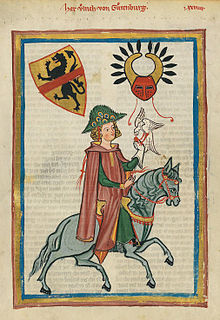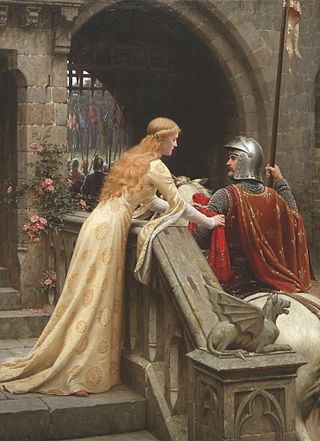
Courtly love was a medieval European literary conception of love that emphasized nobility and chivalry. Medieval literature is filled with examples of knights setting out on adventures and performing various deeds or services for ladies because of their "courtly love". This kind of love was originally a literary fiction created for the entertainment of the nobility, but as time passed, these ideas about love spread to popular culture and attracted a larger literate audience. In the high Middle Ages, a "game of love" developed around these ideas as a set of social practices. "Loving nobly" was considered to be an enriching and improving practice.

Modern lyric poetry is a formal type of poetry which expresses personal emotions or feelings, typically spoken in the first person.
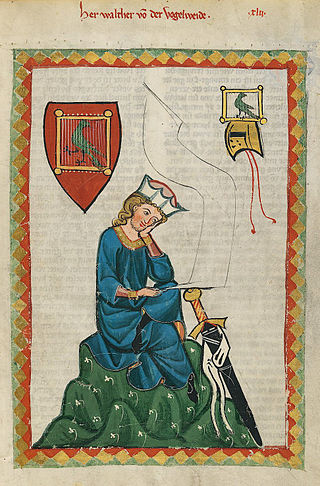
Minnesang was a tradition of lyric- and song-writing in Germany and Austria that flourished in the Middle High German period. This period of medieval German literature began in the 12th century and continued into the 14th. People who wrote and performed Minnesang were known as Minnesänger, and a single song was called a Minnelied.

Wolfram von Eschenbach was a German knight, poet and composer, regarded as one of the greatest epic poets of medieval German literature. As a Minnesinger, he also wrote lyric poetry.

Chrétien de Troyes was a French poet and trouvère known for his writing on Arthurian subjects such as Gawain, Lancelot, Perceval and the Holy Grail. Chrétien's chivalric romances, including Erec and Enide, Lancelot, Perceval and Yvain, represent some of the best-regarded works of medieval literature. His use of structure, particularly in Yvain, has been seen as a step towards the modern novel.

Walther von der Vogelweide was a Minnesänger who composed and performed love-songs and political songs ("Sprüche") in Middle High German. Walther has been described as the greatest German lyrical poet before Goethe; his hundred or so love-songs are widely regarded as the pinnacle of Minnesang, the medieval German love lyric, and his innovations breathed new life into the tradition of courtly love. He was also the first political poet to write in German, with a considerable body of encomium, satire, invective, and moralising.
Poetry took numerous forms in medieval Europe, for example, lyric and epic poetry. The troubadours, trouvères, and the minnesänger are known for composing their lyric poetry about courtly love usually accompanied by an instrument.
A lai is a lyrical, narrative poem written in octosyllabic couplets that often deals with tales of adventure and romance. Lais were mainly composed in France and Germany, during the 13th and 14th centuries. The English term lay is a 13th-century loan from Old French lai. The origin of the French term itself is unclear; perhaps it is itself a loan from German Leich (reflected in archaic or dialectal English lake, "sport, play" and in modern Swedish. The terms note, nota and notula appear to have been synonyms for lai.
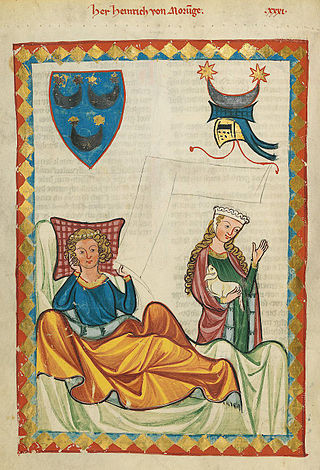
Heinrich von Morungen was a Minnesinger, whose 35 surviving Middle High German songs are dated on both literary and biographical grounds to around the period 1190–1200. Alongside Walter von der Vogelweide and Reinmar he is regarded as one of the most important Minnesänger: he was "the most colourful, passionate, tender and musical of the Minnesänger" and his work "marks a new and brilliantly effective stage in the development of the German lyric."

Lanzelet is a medieval romance written by Ulrich von Zatzikhoven after 1194. It is the first treatment of the Lancelot tradition in German, and contains the earliest known account of the hero's childhood with the Lady of the Lake-like figure in any language. The poem consists of about 9,400 lines arranged in 4-stressed Middle High German couplets. It survives complete in two manuscripts and in fragmentary form in three others.
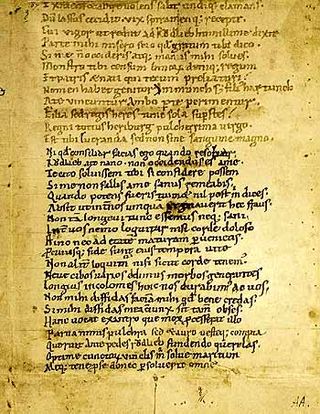
Ruodlieb is a fragmentary romance in Latin verse written by an unknown southern German poet who flourished about 1030. He was almost certainly a monk of the Bavarian Tegernsee Abbey.

Spruchdichtung or Sangspruchdichtung is the German term for a genre of Middle High German sung verse. An individual work in this genre is called a Spruch, literally a "saying", and may consist of one or more strophes.
Middle High German literature refers to literature written in German between the middle of the 11th century and the middle of the 14th. In the second half of the 12th century, there was a sudden intensification of activity, leading to a 60-year "golden age" of medieval German literature referred to as the mittelhochdeutsche Blütezeit. This was the period of the blossoming of Minnesang, MHG lyric poetry, initially influenced by the French and Provençal tradition of courtly love song. The same sixty years saw the composition of the most important courtly romances. again drawing on French models such as Chrétien de Troyes, many of them relating Arthurian material. The third literary movement of these years was a new revamping of the heroic tradition, in which the ancient Germanic oral tradition can still be discerned, but tamed and Christianized and adapted for the court.

Cyril William Edwards was a British medievalist and translator. Teaching in London and Oxford, he published extensively on the medieval German lyric and Old High German literature, and translated four of the major Middle High German verse narratives.
Peter von Staufenberg is a Middle High German verse novella in 1,192 lines. It was written around 1310 by Egenolf von Staufenberg.
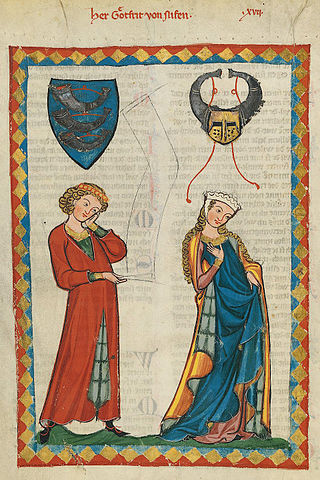
Gottfried von Neifen was a German Minnesänger.
In the Middle High German (MHG) period (1050–1350) the courtly romance, written in rhyming couplets, was the dominant narrative genre in the literature of the noble courts, and the romances of Hartmann von Aue, Gottfried von Strassburg and Wolfram von Eschenbach, written c. 1185 – c. 1210, are recognized as classics.
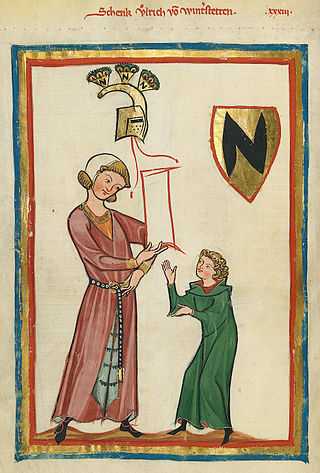
Ulrich von Winterstetten was a German nobleman, priest and Minnesänger.

Herrand von Wildonie was a German nobleman and poet.

König Rother is the earliest Middle High German epic poem. It consists of 5,204 lines of rhymed couplets. The author is unknown, but was probably a clergyman writing in Bavaria. It was written no earlier than 1152, probably before 1180. The earliest manuscript, Heidelberg Cpg 390, is from around 1200 and is also the only complete copy. Three fragmentary manuscripts from the 13th and 14th centuries are known.
